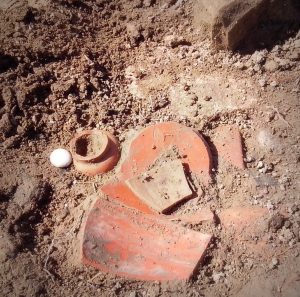
Roman game piece in situ
“So intense was the love of the Roman for games of hazard, that wherever I have excavated the pavement of a portico, of a basilica, of a bath, or any flat surface accessible to the public, I have always found gaming tables engraved or scratched on the marble or stone slabs, for the amusement of idle men, always ready to cheat each other out of their money” as archeologist Rodolfo Lanciani tells in Gambling and Cheating in Ancient Rome.
The stones of the archaeological sites tell us about a long time of engravings and small traces of humanity, and the reconnaissance on the spot has allowed us to find many testimonies of these signs left by man. Reconstruction of ancient games is a very complicated topic, where archaeological evidence, literary sources and knowledge of the general mechanisms of board games have to be combined. Through the game, it is possible to create an anthropological framework that can be compared with the source descriptions, with images of paintings, sculptures and any ancient source that will help us to delineate public spaces in such remote times.
In various cities of the Roman Empire, many games were discovered carved on paving slabs or on the steps of public monuments such as basilicas or temples. There have also been findings in the guard stations of medieval fortresses and church cloisters. Man has played since ancient times and our goal is simply to continue this tradition of entertainment and spend time sharing these discoveries with an ever-widened audience..
In the reproduction of the games, information from literary sources could not be disregarded, searching to interpret passages that were not always clear. The analysis of these sources, thanks to the aid of knowledge of ancient languages, permitted the revival of games practiced in ancient times. Literary sources provided information concerning the names of games and their rules, although these were often problematic, given that they were poetic allusions or bound philosophically to the games rather than true explanations, or otherwise they were written by later authors, who gained their knowledge from previous literary sources. Often there have been cases in which some contemporaneous writers mistook the rules of one game with that of another, creating much confusion in the interpretation of the board games, most certainly due to the scarcity of information from historic sources.
Examples of board games on frescoes or mosaics, on sculptures and other works of art have also been examined, maintaining consideration that they follow the precise laws in terms of subject style, scale and perspective, and that often details of the games illustrated are unrecognisable or misleading.
Regarding the feasibility of the games, this has availed in their reproduction and has permitted repeated experimentations of the suggested rules. The reconstruction of the game rules are as close to the ancient ones as possible, for some it was easier, for others hypotheses have been created based on comparisons and logic. They have been compared with games which survived in later periods, sometimes those which still exist today, such as in the case of Backgammon or Mill.
Follow our research..ludus in tabula!

Monica Silvestri at the Agorà of Athens

Royal Game of Ur from British Museum

tabula lusoria engraved on the steps of the Basilica Iulia in the Roman Forum

Monica Silvestri during the study of the finds

